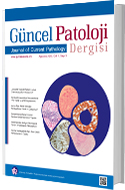2Department Of Pediatric Surgery, Recep Tayyip Erdogan University Of Medical Faculty, Rize, Turkey.
Introduction
Myxomas are benign tumors and generally arise from the heart, soft tissues, muscle, skin and bone. This term, myxoma, was first defined by Virchowas tumors containing intercellular mucin resembling the structure of umbilical cord. Later, the myxoma criteria was determined by Stautas the tumorsconsisting ofstellate or spindle-shaped cells in a myxoid stroma containing different ratios of mucopolysaccharides between thin reticulin fibers. Herein we will present a myxoma case determined on the right ovary of a 12 years old girl.
Case report
Twelve years old girl was under follow-up for menstrual irregularities for 1 year and pelvic ultrasonography revealed bilateral para-ovarian simple semisolid lesions. Pelvic magnetic resonance (MR) imaging was performed and a cystic lesion on right adnexal region with 65x4cm dimensions that was hyperintense on T2 AG and hypointense T1 AG was observed which was having nodular diffuse contrast enhancement on posterior wall after intravenous contrast injection. Ovarian tumor markers and routine laboratory evaluations were all in normal limits. Right adnexal para-ovarian cystic mass was totally excised. Macroscopically, 6x4.5x3 cm dimensions and 32 gram weight was bloody on appearance; and a solid myxoid area of 3x2.5 cm was observed on one side. Microscopically, there was a tumor consisting of stellate or spindle-shaped tumor cells in a large myxoid matrix. There was not any increase in cellularity, nuclear polymorphism, mitosis or necrosis determined in tumor. In histochemical evaluation, positive staining with Alcian blue was observed in myxomatous stroma. Immunohistochemical investigations revealed diffuse positive staining with smooth muscle actin (SMA) and vimentin and negative stainings with desmin, inhibin, cytokeratin and S-100 protein in tumor.’ With all those findings the case was diagnosed as ovarian myxoma.
Conclusion
Ovarian myxoma is a quite rare condition which is a different entity. Myxomas originate from the connective tissue of different organs. These tumors most commonly arise from skeletal muscle and heart and in general they do not have a significant clinical sign.The differential diagnosis of ovarian myxomas with other ovarian myxoid lesions should be performed. The differential diagnosis include angio-myxomas, fibromas with widespread myxoid degeneration, and primary ovarian stromal lesions containing high amounts of myxoid matrix such as massive edema, or non-ovarian stromal lesions that are generally malign. In massive edema of ovaries, around the edematous tissue normal residual ovarian stromal structures and intercellular structures together with mucin negativity in connective tissue are observed.In conclusion, ovarian myxomas are rare and they should be differentiated from other lesions of ovaries with myxoid alterations.
Anahtar Kelimeler : Ovary, Myxoma, Myxomatous stroma, Alcian blue


